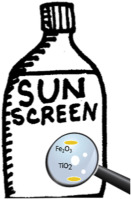Our official English website, www.x-mol.net, welcomes your
feedback! (Note: you will need to create a separate account there.)
Accurate quantification of TiO2 nanoparticles in commercial sunscreens using standard materials and orthogonal particle sizing methods for verification.
Talanta ( IF 5.6 ) Pub Date : 2020-03-15 , DOI: 10.1016/j.talanta.2020.120921 Milica Velimirovic 1 , Stephan Wagner 2 , Fazel Abdolahpur Monikh 3 , Toni Uusimäki 4 , Ralf Kaegi 4 , Thilo Hofmann 3 , Frank von der Kammer 3
Talanta ( IF 5.6 ) Pub Date : 2020-03-15 , DOI: 10.1016/j.talanta.2020.120921 Milica Velimirovic 1 , Stephan Wagner 2 , Fazel Abdolahpur Monikh 3 , Toni Uusimäki 4 , Ralf Kaegi 4 , Thilo Hofmann 3 , Frank von der Kammer 3
Affiliation

|
The implementation and enforcement of product labeling obligation as required, for example, by the cosmetic product regulation, needs simple and precise validated analytical methods. This also applies to the analysis of nanoparticles in products such as cosmetics. However, the provision of such methods is often hampered by inaccurate sizing due to unwanted nanoparticle changes, interference of matrix components with sizing and interactions between nanoparticles and analytical instrumentation. It is, therefore, necessary to develop appropriate sample preparation methods that preserve NP properties and reduce or remove matrix compounds that interfere with sizing. Further, accurate particle size analysis of samples containing unknown and possibly multiple nanoparticulate constituents is needed. In this study, we evaluated three sample preparation methods to identify and quantify TiO2 nanoparticles in sunscreens. Specifically, we used a combination of ultracentrifugation and hexane washing, thermal destruction of the matrix, and surfactant assisted particle extraction. The method accuracy was assessed by two internal reference samples: pristine TiO2 nanoparticles (NM104) and similar TiO2 nanoparticles dispersed in a sunscreen matrix. The PSDs were determined using an asymmetrical flow field-flow fractionation hyphenated with multi-angle light scattering and inductively coupled plasma-mass spectroscopy. Particle sizing was based on size calibration of the particle retention time in the AF4. Computation of radius of gyration from MALS data was used as an orthogonal particle sizing approach to verify ideal elution and particle size data from the AF4 calibration. Among the three tested sample preparation methods surfactant assisted particle extraction revealed TiO2 nanoparticle recoveries of above 90% and no increase in particle size due to sample preparation was observed. Finally, the sample preparation methods were applied to two commercial sunscreen samples revealing the existence of TiO2-NP < 100 nm. Conclusively, the surfactant assisted particle extraction method can provide valid data for TiO2-NPs in sunscreen and possibly for cosmetic samples of similar matrix.
中文翻译:

使用标准材料和正交粒径测量方法对商用防晒霜中的TiO2纳米颗粒进行准确定量,以进行验证。
根据化妆品法规的要求执行和执行产品标签义务,需要简单且精确的经过验证的分析方法。这也适用于分析化妆品等产品中的纳米颗粒。然而,由于不期望的纳米颗粒变化,尺寸变化对基质组分的干扰以及纳米颗粒与分析仪器之间的相互作用,常常会由于尺寸不准确而妨碍提供此类方法。因此,有必要开发适当的样品制备方法,以保留NP特性并减少或去除干扰施胶的基质化合物。此外,需要对包含未知且可能多种纳米颗粒成分的样品进行准确的粒度分析。在这个研究中,我们评估了三种样品制备方法,以鉴定和定量防晒霜中的TiO2纳米颗粒。具体而言,我们将超速离心和己烷洗涤,基质的热破坏和表面活性剂辅助的颗粒提取结合起来使用。通过两个内部参考样品评估了方法的准确性:原始的TiO2纳米颗粒(NM104)和分散在防晒霜基质中的类似的TiO2纳米颗粒。使用多角度光散射和电感耦合等离子体质谱联用的不对称流场-流分离确定PSD。颗粒大小基于AF4中颗粒保留时间的尺寸校准。根据MALS数据计算回转半径用作正交粒度分析方法,以验证AF4校准的理想洗脱和粒度数据。在三种测试的样品制备方法中,表面活性剂辅助的颗粒萃取显示TiO2纳米颗粒的回收率超过90%,并且未观察到由于样品制备而导致的粒径增加。最后,将样品制备方法应用于两个商业防晒样品,揭示了TiO2-NP <100 nm的存在。结论是,表面活性剂辅助的颗粒提取方法可以为防晒霜中的TiO2-NPs提供有效数据,并可能为相似基质的化妆品样品提供有效数据。在三种测试的样品制备方法中,表面活性剂辅助的颗粒萃取显示TiO2纳米颗粒的回收率超过90%,并且未观察到由于样品制备而导致的粒径增加。最后,将样品制备方法应用于两个商业防晒霜样品,发现存在TiO2-NP <100 nm。最终,表面活性剂辅助的颗粒提取方法可以为防晒霜中的TiO2-NPs提供有效数据,并可能为相似基质的化妆品样品提供有效数据。在三种测试的样品制备方法中,表面活性剂辅助的颗粒萃取显示出TiO2纳米颗粒的回收率超过90%,并且未观察到由于样品制备而导致的粒径增加。最后,将样品制备方法应用于两个商业防晒样品,揭示了TiO2-NP <100 nm的存在。总之,表面活性剂辅助的颗粒提取方法可以为防晒霜中的TiO2-NPs提供有效数据,并可能为相似基质的化妆品样品提供有效数据。
更新日期:2020-03-16
中文翻译:

使用标准材料和正交粒径测量方法对商用防晒霜中的TiO2纳米颗粒进行准确定量,以进行验证。
根据化妆品法规的要求执行和执行产品标签义务,需要简单且精确的经过验证的分析方法。这也适用于分析化妆品等产品中的纳米颗粒。然而,由于不期望的纳米颗粒变化,尺寸变化对基质组分的干扰以及纳米颗粒与分析仪器之间的相互作用,常常会由于尺寸不准确而妨碍提供此类方法。因此,有必要开发适当的样品制备方法,以保留NP特性并减少或去除干扰施胶的基质化合物。此外,需要对包含未知且可能多种纳米颗粒成分的样品进行准确的粒度分析。在这个研究中,我们评估了三种样品制备方法,以鉴定和定量防晒霜中的TiO2纳米颗粒。具体而言,我们将超速离心和己烷洗涤,基质的热破坏和表面活性剂辅助的颗粒提取结合起来使用。通过两个内部参考样品评估了方法的准确性:原始的TiO2纳米颗粒(NM104)和分散在防晒霜基质中的类似的TiO2纳米颗粒。使用多角度光散射和电感耦合等离子体质谱联用的不对称流场-流分离确定PSD。颗粒大小基于AF4中颗粒保留时间的尺寸校准。根据MALS数据计算回转半径用作正交粒度分析方法,以验证AF4校准的理想洗脱和粒度数据。在三种测试的样品制备方法中,表面活性剂辅助的颗粒萃取显示TiO2纳米颗粒的回收率超过90%,并且未观察到由于样品制备而导致的粒径增加。最后,将样品制备方法应用于两个商业防晒样品,揭示了TiO2-NP <100 nm的存在。结论是,表面活性剂辅助的颗粒提取方法可以为防晒霜中的TiO2-NPs提供有效数据,并可能为相似基质的化妆品样品提供有效数据。在三种测试的样品制备方法中,表面活性剂辅助的颗粒萃取显示TiO2纳米颗粒的回收率超过90%,并且未观察到由于样品制备而导致的粒径增加。最后,将样品制备方法应用于两个商业防晒霜样品,发现存在TiO2-NP <100 nm。最终,表面活性剂辅助的颗粒提取方法可以为防晒霜中的TiO2-NPs提供有效数据,并可能为相似基质的化妆品样品提供有效数据。在三种测试的样品制备方法中,表面活性剂辅助的颗粒萃取显示出TiO2纳米颗粒的回收率超过90%,并且未观察到由于样品制备而导致的粒径增加。最后,将样品制备方法应用于两个商业防晒样品,揭示了TiO2-NP <100 nm的存在。总之,表面活性剂辅助的颗粒提取方法可以为防晒霜中的TiO2-NPs提供有效数据,并可能为相似基质的化妆品样品提供有效数据。











































 京公网安备 11010802027423号
京公网安备 11010802027423号